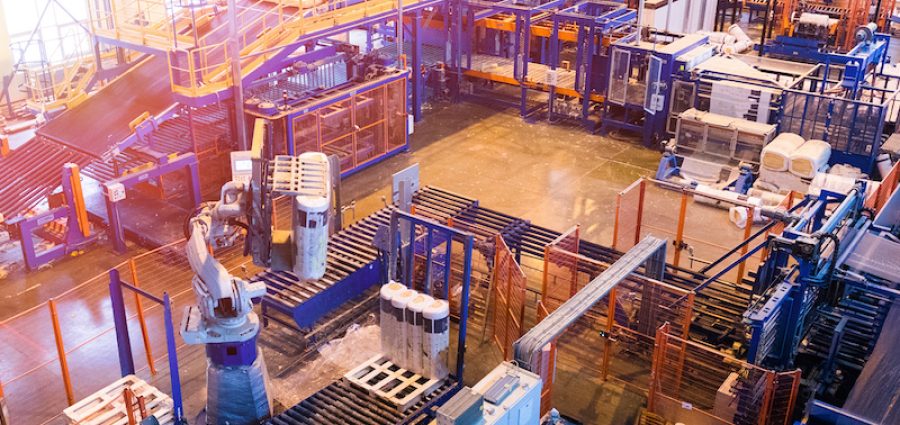The Institute for Supply Management’s monthly Purchasing Managers Index (PMI) — a well-regarded barometer of the U.S. industrial economy — rose slightly in April, according to data released by ISM May 1.
The April PMI mark of 47.1% is up from March’s 46.3%, which was the index’s lowest value since May 2020’s 43.5%. April’s PMI reading, however, remains in contraction territory (anything below 50%) for a sixth straight month. A November PMI mark of 49 snapped 29 straight months of expansion (any reading of 50% or higher).
“The U.S. manufacturing sector contracted again; however, the Manufacturing PMI® improved compared to the previous month, indicating slower contraction,” ISM Manufacturing Business Survey Committee Chair Timothy Fiore said in a news release. “The April composite index reading reflects companies continuing to manage outputs to better match demand for the first half of 2023 and prepare for growth in the late summer/early fall period.”
| Month | Manufacturing PMI | Month | Manufacturing PMI |
| April 2023 | 47.1 | Sept 2022 | 51.0 |
| March 2023 | 46.3 | Aug 2022 | 52.9 |
| Feb 2023 | 47.7 | July 2022 | 52.7 |
| Jan 2023 | 47.4 | June 2022 | 53.1 |
| Dec 2022 | 48.4 | May 2022 | 56.1 |
| Nov 2022 | 49.0 | April 2022 | 55.9 |
| Oct 2022 | 50.0 | March 2022 | 57.0 |
| Average for last 12 months – 50.1; High – 56.1; Low – 46.3 | |||
Fiore noted that, of the six biggest manufacturing industries, two — petroleum & coal products and transportation equipment — registered growth in April. Of the 18 industries ISM tracks, three others — printing & related support activities; apparel, leather & allied products; and fabricated metal products — reported growth. 11 industries reported contraction in April.
“New order rates remain sluggish as panelists remain concerned about when manufacturing growth will resume,” Fiore said. “Panelists’ comments registered a 1-to-1 ratio regarding optimism for future growth and continuing near-term demand declines. Supply chains are prepared and eager for growth, as panelists’ comments support reduced lead times for their more important purchases. Price instability remains and future demand is uncertain as companies continue to work down overdue deliveries and backlogs.”
Here is a sample of ISM manufacturing PMI survey respondent commentary for April:
- “Having invested heavily to de-risk the supply chain over the last three years due to COVID-19, we are looking to reset with a number of our suppliers to reduce inventory, which has grown steadily over that period. Lead times are generally coming down, although electronic components are still a concern.” (Computer & Electronic Products)
- “Business continues to contract, albeit slowly year over year. We are burning existing inventory when possible and catching up on orders. Suppliers are shipping materials at a faster pace, especially to get the payable process started at the end of the first quarter. Employment is steady, with manpower decisions based on expected order flow in the second quarter, which is subject to change. Staffing levels in our sector are not decreasing, but employment openings are slowing across the economy, which reduces the pool of replacement candidates. We are currently projecting that the third quarter will see some improvement in business, especially in our metals coating for the aerospace industry. But unforeseen circumstances — international or domestic — could change things quickly.” (Chemical Products”
- “Pricing pressures continue to plague daily operations. After consecutive years of inflation and aggressive pricing to our retailers, we are starting to see resistance in the willingness to pass along pricing to end consumers. Discounting has entered into conversations.” (Food, Beverage & Tobacco Products)
- “Business is steady. Closely monitoring demand going forward to detect a negative trend.” (Transportation Equipment)
- “Customers seem to be quite heavy on inventory (as is my employer). This has made for a significant slowdown in sales orders for the last number of months.” (Machinery)
- “Faster deliveries and shorter lead times from suppliers. … Customers starting to talk build rate reductions for the second half of 2023.” (Fabricated Metal Products)
- “Business conditions remain strong, with sales and bookings exceeding plan. The backlog continues to grow due to increased bookings and supply chain constraints on electronic components.” (Miscellaneous Manufacturing)
- “Sales continue to be soft, similar to 2019 pre-COVID. Expect softness to last for as long as another two years.” (Electrical Equipment, Appliances & Components)
- “Business is picking up a bit in the automotive and construction industries — not on par with 2022 but beginning to look better.” (Plastics & Rubber Products)
- “We seem to be in a season of contradictions. Business is slowing, but in some ways, it isn’t. Prices for some commodities are stabilizing, but not for others. Some product shortages are over, others aren’t. Trucking is more plentiful, except when it isn’t. There’s uncertainty one day, but not the next. The next couple of months should provide answers — or not. It’s hard to make projections at the moment.” (Primary Metals)
Related Posts
-
The well-regarded barometer of U.S. manufacturing rose for the first time since August, but remains…
-
The industrial manufacturing barometer fell another 1.2 points from October, continuing its year-long slide.
-
Last month, the Consumer Price Index was up 7.7% from October 2021, according to data…






